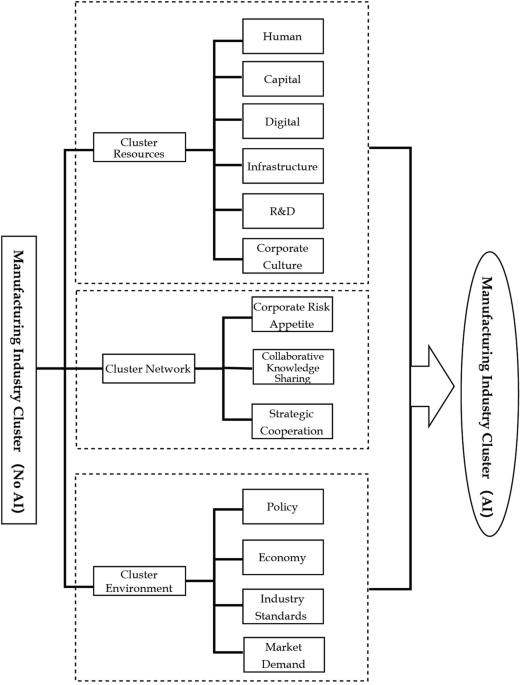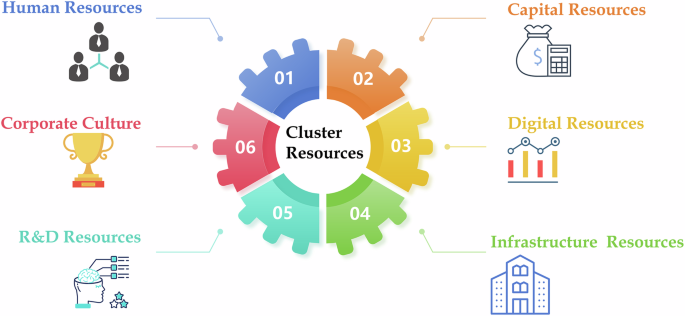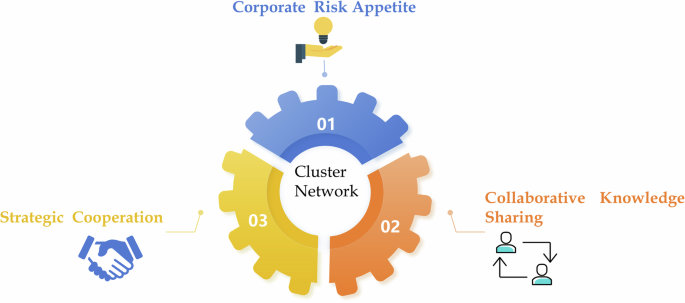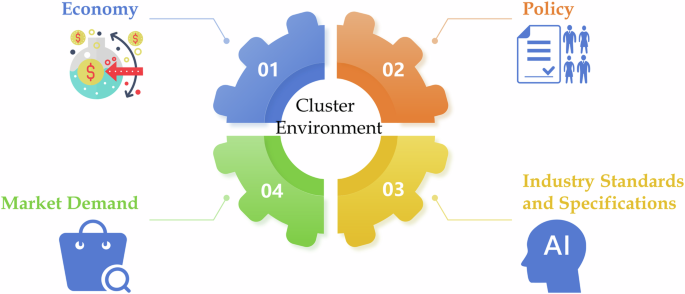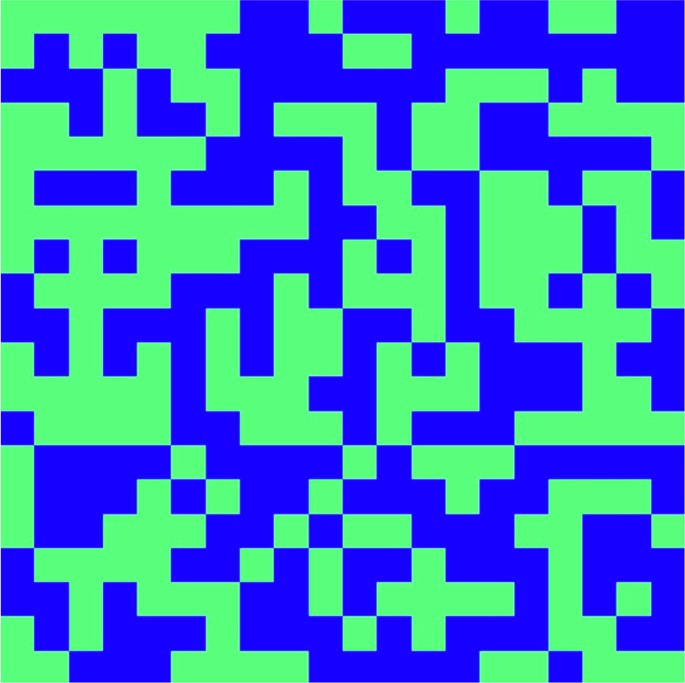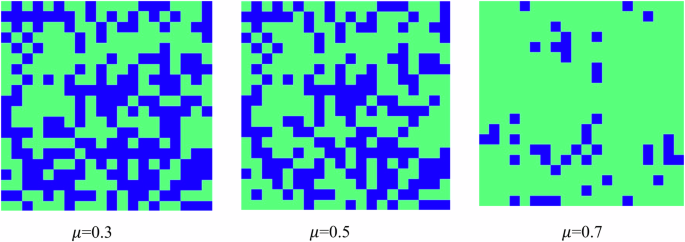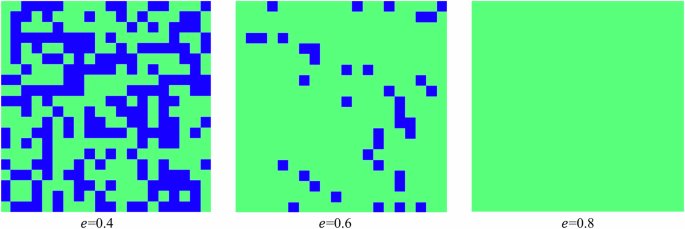制造集群中人工智能创新的驱动因素:蜂窝自动机模拟的见解
作者:Guo, Liang
介绍
人工智能(AI)技术的快速发展引发了多个行业的全球转变,推动了经济增长并重塑创新生态系统(Babina等,2024;Polak和Anshari,2024)。在制造业中,AI扮演着越来越关键的角色,尤其是在AI支持的制造集群中,地理集中的网络中,AI技术将AI技术深深地嵌入了制造业企业,资源基础架构和协作机构中(Wan等人,资源基础架构和协作机构)2020)。这些集群是创新枢纽,促进知识交流,资源优化和集体学习,从而加速制造业转型并增强区域竞争力(Cappiello等人,Cappiello等人,,2020)。
广泛的文献研究了工业集群在促进创新中的作用,突出了诸如集群资源,公司间网络和监管环境等关键驱动因素(Lai等,,2014;Qiu等人,2024;Speldekamp等,2020;Yuan和Hai Zhang,2020)。迈克尔·波特(Michael Porter)的群集理论强调了集群如何通过共享资源来提高生产力,通过动态的本地网络刺激创新并促进新业务的出现,从而有助于区域经济活力和可持续性(Connell等,,Connell等。2014;搬运工,1998)。但是,簇对公司增长的影响是多方面的。包括Yasuyuki Motoyama在内的批评家认为,波特的理论过于描述性,并且由于其对集群起源和公共部门的参与不足(Motoyama,Motoyama,2008)。彼得·桑利(Peter Sunley)进一步批评了理论的概念模糊性,这使它的应用和测量变得复杂。他强调了考虑文化,机构和市场动态等因素的必要性,以了解集群的成功(Martin and Sunley,2003)。
尽管有这些批评,但关于工业集群中技术创新的文献为AI转化制造过程的潜力提供了宝贵的见解。研究表明,AI的采用可以导致效率,质量控制和决策的实质性提高(Hao and Demir,2023;Putra等人,2024;Quispe等,2023)。
然而,尽管以前的研究研究了传统工业集群中的创新动态,但这些驱动因素在AI-a-a-Subinage clusters中的具体相互作用仍未得到充实。
当前研究中的一个关键差距是制造集群中AI驱动创新的集体动态,尤其是公司间网络在促进此类创新方面的作用。这些集群中的AI创新是由经济,技术和社会因素的复杂相互作用所塑造的,在整个演变中都遇到了挑战和机遇(Lazzeretti等,2023)。虽然文献承认AI的潜力提高了效率(Waltersmann等人,2021;Wan等人,2020),改善质量控制(Arinez等,,2020;Escobar等人,2023),并优化决策(Chien等,2020;gonzâlez-castaã±等。2022),关于集群资源,企业间网络和监管环境如何共同影响AI驱动的制造创新的出现和扩散,存在不足的见解。解决这一差距需要全面探索这些因素如何相互作用和塑造AI扩散模式。
近年来,基于模拟的方法(例如细胞自动机(CA))研究了这些复杂的相互作用(Gregorio和Serra,,,1999;Hegselmann和Flache,1998)。CA模型有效地捕获了集群中资源共享,协作和竞争的动态特征,从而提供了有关AI创新如何弥漫在制造生态系统中的新型计算观点(Kotyrba等,,,,。2015;Shan等人,2024)。
这项研究旨在通过明确检查AI支持的制造簇的进化机制和驱动力来弥合这一差距。基于进化的经济地理理论和复杂系统理论,我们开发了一个理论框架,并构建了基于蜂窝自动机的仿真模型,以研究集群资源,企业间网络和集群环境如何共同塑造制造群体中AI技术的采用和扩散。
这项研究的发现有助于更深入地了解聚类的创新生态系统以及在AI背景下集体学习和竞争优势的理论基础。此外,这项研究为政策制定者和行业领导者提供了实用的见解,提供了有针对性的干预措施和战略计划建议,以增强AI-a-a-Subinassing制造集群的发展。通过将支持AI的制造簇概念化为复杂的自适应系统,这项研究突出了微型驱动因素(例如,公司级AI的采用,企业间的合作)和宏观级别的成果(例如工业转型,区域经济增长)之间的相互作用。这种基于系统的方法为对AI驱动创新生态系统的未来研究铺平了道路。
本文的其余部分的结构如下:“理论框架和进化模型”详细介绍了细胞自动机模型设计;``仿真分析''介绍模拟结果和分析;讨论和结论节讨论了优化AI群集开发的理论贡献和政策含义。理论框架和进化模型
这项研究的理论框架整合了两种互补理论:进化经济地理理论和复杂的系统理论,特别关注细胞自动机(CA)建模和仿真。
这个集成的框架旨在全面了解集群创新生态系统中的动态,同时还建立了在AI驱动的制造创新的背景下为集体学习和竞争优势的理论基础。
进化经济地理理论
进化经济地理是一种理论方法,将经济格局视为一种复杂的适应系统。它突出了竞争,空间环境,技术变革和历史时间在通过多样性,选择,保留以及公司和行业的空间动态等过程中塑造经济区域中的作用。该理论通过其他概念(例如可塑性,鲁棒性和自组织)综合了达尔文原理(马丁和桑利,2006)。在这一理论中,相关经济活动的空间集中被视为创新的主要驱动力。公司和行业的集群通过知识溢出,协作学习和资源共享等机制促进了创新,所有这些都为区域竞争优势做出了贡献。在AI驱动的制造创新的背景下,该理论表明,集群,公司间网络中的资源以及集群的监管环境共同影响创新的出现和扩散。具体而言,集群中公司的邻近性可实现知识交流和协作学习,而监管环境在塑造或限制激励结构和知识共享实践中起着至关重要的作用。
AI创新驱动力的分析
在这项研究中,我们定义了利用AI技术作为企业,机构和资源网络的制造业集群,这些网络将人工智能(AI)集成为促进制造业内的增长和创新。这些集群包括高级制造企业,研究机构,资金机制和协作网络,所有这些都致力于应用旨在优化生产过程,简化供应链和推动产品创新的AI解决方案(Lee等人,2018;Rizvi等人,2021;Zdravkoviä等,2021)。这些支持AI的制造簇的定义特性包括:AI技术的集成,例如预测性维护,智能制造,自动化和数据分析,以提高运营效率和生产力。访问共享资源,包括专业知识,熟练劳动力,数字基础设施以及针对AI应用程序量身定制的金融资本。协作网络促进了制造公司,AI开发人员和研究机构之间知识交流,技术采用和共同创新的协作网络。支持环境的特征是有利的政策,市场动态和社会经济因素,这些因素鼓励在制造集群中采用和扩展AI技术(Haricha等人,Haricha等,2023;Jagatheesaperumal等人,2022;Wan等人,2020)。
根据进化经济地理理论并综合了现有研究,本文提出了一个综合模型,概述了人工智能(AI)创新的主要驱动力及其在制造业群集中的后续演变。数字1提供此模型的视觉表示。如图所示。1,制造集群中AI创新的进展得到了三个主要驱动力的支持。
集群资源
集群资源,包括人力资本,金融资本,数字基础设施,研发能力和企业文化,对于促进制造业企业中的AI创新至关重要。在图中可视化了这种资源组成,包括人力资本,金融资产和数字基础架构。2,这说明了驱动集群创新潜力的关键组件。战略性人力资源规划(HRP)通过关注核心人才来增强集群的价值,从而提高竞争力(Shen,Shen,2011)。资本资源通过塑造市场竞争并通过发展金融工业集群来促进金融企业的活力来影响工业集群(Ali等,2014)。数字资源通过将公司整合到创新的集群结构中来为工业集群做出贡献,这反过来又为在城市环境中引入数字经济元素创造了有利的环境(Ivanenko等人,Ivanenko等。2019)。基础设施的建设通过吸引公司,促进工业转型,增强区域创新,推动经济增长并支持向工业中心的过渡来积极影响工业集群。该基础设施的有效性取决于当地条件,例如熟练劳动和资本的可用性(Wu等人,2023)。研发能力是吸引新公司并增强工业集群中创新和绩效的关键(Leung and Sharma,2021)。此外,企业文化通过促进员工敬业度,推动创新和增强竞争力来发挥关键作用。它刺激企业家精神,塑造政策制定,并促进技术的引入和扩散(Putilova和Shutaleva,2020)。
在AI驱动的制造创新的背景下,集群中的大量资源积极影响集群创新生态系统中运营的公司对新创新的探索。根据进化经济地理理论,相关经济活动的空间集中度通过知识溢出,协作学习和资源共享等机制来促进创新。结果,由于特殊知识,熟练的劳动力和先进的技术基础设施的可用性,位于资源丰富的集群中的公司更倾向于追求新的AI驱动制造创新。显然,制造业集群在促进AI创新的发展中起着至关重要的作用。
集群网络
工业集群网络代表了一个复杂的局部互连企业系统,其特征是自由规模的属性。该网络通过诸如公司风险食欲,协作知识共享和战略合作等机制来促进创新,资源整合和经济发展(Abhari等,,2019)。如图所示。3,这些组件构成集群网络的核心框架。在这种情况下,工业集群网络的结构显着影响知识扩散和创新的效率(Schilling and Phelps,2007)。此外,企业风险偏好会在工业集群中塑造行为和战略选择,影响合作水平,并需要预防可持续发展的风险策略(刘和Xu,2018)。这些集群中的知识共享通过降低成本和风险来增强经济绩效,创新和竞争力,并受到承诺和领导能力等因素的影响(Wang等,Wang等。2017)。此外,工业集群内的战略合作促进了公司的聚集,支持行业形成,增强区域创新并提高竞争力。这些策略因行业类型和区域条件而异(Baldassarre等,2019)。
尽管地理接近性为资源汇集和互动提供了优势,但它本身并不能保证公司内部公司的全球竞争力(Lee,Lee,2018)。建立和利用国际联系的能力是寻求进入全球市场,高级技术和多元化人才库的公司的关键因素(Rugman等,,,2012)。此外,集群的组成以相似和互补的企业为特征,显着影响其创新动力。竞争性的公司通常会互相推动提高效率和创新,而补充公司通过整合整个价值链的专业知识和资源(Hermundsdottir和Aspelund,Aspelund,2021;Maciel和Fischer,2020)。这些相互作用强调了结构良好的企业间网络在培养知识共享作为持续创新的催化剂的环境中的重要作用。
企业间网络的强度积极影响了集群创新生态系统中公司中AI驱动的制造创新的传播。强大而冒险的企业间网络促进知识交流,协作学习以及对AI驱动的制造创新至关重要的共同解决问题的元素。嵌入良好连接的网络中的公司可以利用这些关系来访问有价值的信息和资源,从而增强其传播创新的能力(Aviv等,,。2019)。因此,必须加强建立集群网络,以促进制造工业集群的发展并促进其过渡到更复杂的阶段。
集群环境
工业集群环境包括各种因素,包括经济,政策,行业标准和规格以及市场需求,所有这些因素都对集群内的人才增长产生了积极影响(Weng,2008)。在图中图中描述了集群环境中的这些因素。4。经济环境通过促进人才增长,促进经济扩张,增强商业环境并将群集整合到全球网络(Narayana,Narayana,2014)。国家支持的政策可以促进工业集群的增长和发展,从而导致经济利益和减轻贫困(Shakib,Shakib,2020)。行业标准通过提高竞争优势,克服瓶颈并影响经济发展,创新和数字化转型来增强工业集群的发展(Li and Wu,2016)。市场需求通过降低平均成本和影响区域经济增长来影响工业集群的发展,这可能导致GDP,劳动力价值,土地和财产价格以及环境后果的增加(Wang,Wang,2018)。
一个支持性的集群环境对集群创新生态系统中公司之间的集体学习产生积极影响,从而有助于区域竞争优势。这样的环境塑造了激励结构,并促进了一种知识共享的氛围,从而促进了公司之间的协作学习和创新。鼓励合作,保护知识产权并为研发提供资金的政策和机构可以激发公司从事集体学习活动,最终增强集群的竞争优势(Tallman等,Tallman等,2004)。制造业集群中资源和网络的有效利用依赖于一个有利的政治和经济环境,这是将人工智能(AI)整合到这些集群中创新的进化过程中的催化剂。
复杂的系统理论和细胞自动机建模复杂的系统理论
复杂的系统包括自然界的各种现象,其特征是多种因素之间的相互作用(康宁,
1995)。在经济学领域,复杂的系统理论从连通性的角度强调分析,专注于通过元素之间的新连接创造价值(foster,foster,foster,2005)。复杂性理论是自1980年代以来的新兴领域,基于控制理论,信息理论和系统理论等传统理论,同时还整合了新理论,包括耗散结构理论,协同学,灾难理论,混乱理论和超级循环理论。社会本身是一个复杂的系统,社会模拟越来越被公认为是理解人工智能时代社会发展动态的至关重要方法。
社会模拟的核心是建造出现机制,该机制准确地描绘并说明了社会运营的过程和结果。“出现”一词是指该系统的属性或功能,这些系统不是其各个组件中固有的(Hegselmann和Flache,1998)。
通过利用紧急机制来解释复杂的社会系统,社会模拟阐明了社会内部各种系统和层次以及由此产生的社会过程的复杂关系。在1990年代,社会学家卢曼(Luhmann)采用了“系统复杂性”的概念来分析复杂的社会行为,这表明社会系统中的元素之间的牢固相关性可以导致自我组织和自我生成等现象。社会系统体现了典型的复杂系统,其进化模式既不是完全固定的也不是完全随机的。相反,它们在超过临界阈值时聚集在特定的边界和“出现”。因此,出现是复杂社会系统的基本特征。社交模拟可以与大数据和广泛的数据集集成,以超越机械数据的聚合和分析,从而揭示这些系统固有的复杂属性和进化模式。
蜂窝自动机建模
在这项研究中,我们采用细胞自动机(CA)作为建模工具,以模拟AI-a-a-abends制造簇中的动态和新兴行为。首次由冯·诺伊曼(Von Neumann)和乌拉姆(Ulam)在1950年代引入(Crutchfield,2011)。CA因经济学,社会学和生态学等领域被广泛使用,因为它能够捕获产生复杂系统行为的简单组件之间的相互作用。例如,在行业4.0的背景下,基于蜂窝自动机的模型已被用来优化大数据处理,同时最大程度地减少了能源消耗,这是MITRA(2021)提出的具有成本效益的MapReduce模型所证明的。这项工作简化了现有CA规则的复杂性,促进了工业过程中有效的数据改组和整合(Mitra,2021)。在计算研究和工业应用中,蜂窝自动机已被有效地利用其固有的并行性来用于现代平台上的高性能计算,例如多处理器和GPU,产生了重要的建模成果(Waì§s&Sirakoulis,2015; 2015; Was and Sirakoulis;2015)。制造业集群代表了一个复杂的社交网络,其特征是其进化过程的复杂性以及缺乏动态数据所带来的挑战来进行定量分析。这使其特别适合研究制造集群等创新生态系统,在该生态系统中,公司之间的本地化互动可以导致重大的集体成果。
通过利用CA,我们可以对AI技术进行建模如何通过群集扩散,并预测这些生态系统中创新的演变。但是,细胞自动机(CA)通过图像描述模拟这些进化过程的能力以及MATLAB的强大功能使其成为此分析的合适工具。
本研究中开发的细胞自动机仿真模型是专门针对捕获启用AI启用AI型制造簇的独特动态的。这些集群被定义为地理集中的网络,其中AI技术被深入整合到制造业企业,研究机构和协作生态系统中。该模型将三个主要维度(网络和环境)结合到一个计算框架中,以模拟AI驱动创新的采用和演变。
集群资源由人力资本,人工智能基础设施和研发能力等参数表示,这些参数共同影响了AI技术和公司级创新的整合。协作网络被建模为制造公司之间的交互作用,以蜂窝自动机网格上的相邻单元为代表,这些细胞模仿了AI驱动的知识共享,战略联盟和竞争动态。最后,集群环境是通过外部因素(例如政府政策,市场需求和经济状况)来捕获的,所有这些都塑造了采用AI技术并影响集群中公司的集体行为。
该蜂窝自动机框架特别适合建模支持AI的制造簇,因为它捕获了由局部相互作用驱动的新兴行为。例如,配备高级AI工具和大量资源捐赠的公司可以通过溢出效应刺激邻近公司的创新。此外,支持政策和有利的经济环境创造了促进整个集群集体学习和冒险的条件。通过模拟这些维度之间的相互作用,该模型对AI技术如何驱动创新,优化资源并将传统制造簇转变为技术进步的枢纽提供了详细的了解。
通过使模型参数和规则与支持AI支持的制造集群的定义特征,这项研究提供了理论和实际贡献。结果为决策者和行业领导者提供了可行的见解,突出了增强集群资源,加强公司间网络并为AI集成创造支持环境的策略。这种方法不仅可以提高对支持AI的制造生态系统的理论理解,而且还可以作为促进人工智能时代促进工业竞争力和创新的指南。这些发现强调了AI技术在推动系统性创新和区域经济发展方面的变革潜力。
本研究中开发的细胞自动机(CA)模型的结构如下:
$${\text{A}}=({\text{d}},\,{\text{L}}\,{\rm{d}},\,{\text{N}},\,{\text{S}},\,{\text{F}})$$
(1)
In this model:
-
细胞((d): Represents an individual enterprise within the manufacturing industry cluster.
-
Cell Space((ld): Defines the grid system, typically structured asn×nsquare cells, encompassing all enterprises in the industrial cluster.邻里((
-
n): Utilizes the von Neumann configuration, where each cell interacts with its four immediate neighbors (north, south, east, and west).This configuration was selected to mirror localized interactions within manufacturing clusters, where enterprises are primarily influenced by geographically proximate counterparts.The von Neumann neighborhood has been widely employed in Cellular Automata studies for its computational efficiency and its ability to simplify complex systems while preserving spatially-adjacent interaction dynamics.For example, von Neumann’s cellular model demonstrates that localized relationships can effectively simulate broader system behaviors through finite-state automata, supporting its suitability for modeling industrial clusters (Mukhopadhyay,1968年)。
-
Cell State Space((s): Defines the state variablest((我,,,,,j), representing the evolution strategy of the enterprise located at (我,,,,,j) at timet。The state space is binary:$${\mathcal{S}}=\{0,1\}$$
(2)
在哪里
s= 0 means the enterprise remains in its current state without adopting AI-driven innovation, ands= 1 means the enterprise enters the AI innovation cluster.The evolution rules are defined as:The evolution strategies of neighboring enterprises are observable.
Evolution decisions occur sequentially.
-
Evolution Dynamics
-
The probability of state transition is governed by several parameters:
Resource Ownership Coefficient
((p
-
1): Reflects the enterprise’s access to cluster resources (e.g., capital, talent, infrastructure).The more resources a firm has access to (e.g., talent, capital, infrastructure), the more likely it is to adopt AI technologies and influence others in the cluster.It follows a normal distribution:$${p}_{1} \sim N(\mu ,{\sigma }^{2}),\quad 0 < \mu < 1$$
(3)
在哪里
μindicates the mean level of resource ownership.Knowledge Sharing Coefficient
-
((p2): Represents the degree of inter-firm knowledge exchange.Firms that are more connected within the cluster are more likely to engage in knowledge sharing, facilitating the spread of AI adoption.It follows a uniform distribution:
$${p}_{2} \sim {\mathcal{U}}(0,r),\quad 0 < r < 1$$
(4)
在哪里rreflects the affinity for network contact.Cluster Network Capability:
-
Calculated as:$${\text{Network}}\,{\text{Capability}}\,={p}_{2}\times \frac{N(t)}{M}$$
(5)
在哪里
n((t) is the number of AI-adopting enterprises in the neighborhood at timet, 和m= 4 (total neighbors in the von Neumann configuration).The number of neighboring firms that have already adopted AI influences a firm’s decision to adopt AI itself.External Environment Factor((e
-
): Accounts for political, economic, and regulatory influences, which can either support or hinder the adoption of AI technologies within a cluster:The evolution probability for a cell to transition tos = 1 is defined as:
$$p=e\times \left({p}_{1}+{p}_{2}\times \frac{N(t)}{M}\right)$$(7)The state transition follows these rules:
$${S}^{t-1}(i,j)=0,\quad \,{\text{if}}\,{p}\,>\,{p}_{0}\ \Rightarrow \ {S}^{t}(i,j)=1$$
(8)
$${S}^{t-1}(i,j)=1,\quad \ \Rightarrow \ {S}^{t}(i,j)=1$$
(9)
在哪里
p
= 0.6 is the threshold value, optimized for causal emergence effects.
For a full breakdown of model parameters and their distributions (e.g.,μ0,,,,,r
, 和e), refer to Table1, which summarizes the parameter settings aligned with theoretical foundations and prior literature.Table 1 Model parameters and their settings.Complex systems theory, grounded in Cellular Automata modeling and simulation, provides a robust analytical framework for capturing the intricate dynamics and nonlinear interactions among the components of the innovation ecosystem(Chopard et al.,2002)。By simulating the behaviors and adaptation patterns of complex systems, such as innovation clusters, this theory helps predict the emergence and diffusion of AI-driven manufacturing innovations.
Integration of evolutionary economic geography theory and complex systems theoryBy synthesizing the principles of evolutionary economic geography theory with complex systems theory, informed by Cellular Automata modeling, the proposed theoretical framework elucidates the intricate interplay between cluster resources, inter-firm networks, and the cluster environment, as well as the emergence and diffusion of AI-driven manufacturing innovations within industry clusters.The unit of analysis is the firm, which is embedded within the broader innovation ecosystem and engages in collaborative learning and competitive interactions with other firms.
The theory encompasses a feedback loop of exploration and exploitation, wherein firms utilize cluster resources and inter-firm networks to pursue new innovations.
Simultaneously, the cluster environment shapes the development of incentive structures and knowledge-sharing mechanisms that either facilitate or hinder such exploration.
Dialog with existing literature
The proposed theoretical framework builds upon and extends existing theories in evolutionary economic geography by incorporating insights from complex systems theory and Cellular Automata modeling.This integration allows for a more nuanced understanding of the dynamics within clustered innovation ecosystems, capturing the nonlinear interactions and emergent properties of the system.Consequently, the framework offers a comprehensive explanation of how cluster resources, inter-firm networks, and the cluster environment collectively influence the emergence and diffusion of AI-driven manufacturing innovations.
In conclusion, this theoretical framework serves as a valuable lens for examining the dynamics of clustered innovation ecosystems and the theoretical foundations of collective learning and competitive advantage in the context of AI-driven manufacturing innovation.By integrating evolutionary economic geography theory with complex systems theory, informed by Cellular Automata modeling, the framework enhances our understanding of the intricate interplay among cluster resources, inter-firm networks, and the cluster environment in shaping the emergence and diffusion of innovations.This framework can also guide future empirical research and inform policy formulation aimed at fostering innovation.AI-driven innovation clusters play a crucial role in enhancing regional competitiveness.The proposed agent-based model integrates these elements to simulate the dynamics of clustered innovation ecosystems, as well as the theoretical foundations of collective learning and competitive advantage in the context of AI-driven manufacturing innovation.This model investigates the complex interplay between cluster resources, inter-firm networks, and the cluster environment, alongside the exploration-exploitation feedback loop that propels the emergence and diffusion of AI-driven manufacturing innovations within industry clusters.
Simulation analysis
细胞自动机的初始状态模拟
基于细胞自动机(CA)模型,进行了MATLAB模拟。The simulation parameters were set as follows: Cell space size:n = 20, meaning the cellular space consisted of a 20 × 20 grid of cells.Evolution threshold: threshold = 0.6, which was used to determine whether an enterprise (represented by a cell) would transition to an AI innovation state.Number of evolution steps: steps = 30, indicating the number of iterative processes in the simulation.使用MATLAB中的RANDI函数随机生成细胞的初始状态,值为0或1。值为0代表尚未参与制造业行业集群中AI创新演化的公司,而1的值表示企业积极参与进化。The initial state of the cells was randomly generated (see Fig.5)。绿细胞代表了积极参与制造业集群中AI创新演变的公司,而蓝细胞表示尚未参与的公司。数字5illustrates that several firms within the manufacturing industry cluster are already involved in the evolution of AI innovation.
模拟参数对工业集群中AI演变的影响
In the subsequent analysis, we focus on the influence of the related parametersμ,,,,,r, 和eon the evolution of AI innovation clusters within the manufacturing industry.使用细胞自动机理论,对制造集群中AI创新的演化过程进行了定量分析。数字6,,,,,8, 和10depict the state of firms in the cellular space when two parameters are held constant while varying the value of another parameter, after conducting 30 simulations.数字7,,,,,9, 和11provide the corresponding quantitative representations for Figs.6,,,,,8, 和10, respectively, with the horizontal axis denoting the number of simulations and the vertical axis representing the number of AI-innovative firms in the manufacturing industry cluster.
This figure illustrates the AI innovation evolution process in a manufacturing cluster under different resource ownership coefficients (μ= 0.3, 0.5, 0.7) with fixedr= 0.5 and e = 0.5.The first, second, and third images show the cellular space after 30 simulation steps forμ= 0.3, 0.5, and 0.7, respectively.Green cells represent AI-adopting firms (s= 1), and blue cells indicate non-adopting firms (s= 0).
This figure quantifies the number of AI-innovative firms in the manufacturing cluster over 30 simulation iterations for different resource ownership coefficients (μ= 0.3, 0.5, 0.7) with fixedr= 0.5 ande= 0.5.The plot shows three lines, each corresponding to aμvalue, with thex-axis representing simulation steps and they-axis indicating the cumulative number of firms with states= 1.
采用细胞自动机理论,对制造集群中AI创新的进化过程进行了定量分析。数字6,,,,,8, 和10depict the state of firms in the cellular space when two parameters are held constant while varying the value of another parameter, after conducting 30 simulations.数字7,,,,,9, 和11provide the corresponding quantitative representations for Figs.6,,,,,8, 和10, respectively, with the horizontal axis denoting the number of simulations and the vertical axis representing the number of AI-innovative firms in the manufacturing industry cluster.
为了检查集群资源对AI驱动的制造创新的出现和扩散的影响,进行了仿真分析。
In this analysis, the values ofr和ewere fixed at 0.5, while theμvalue was iterated to obtain various states and assess the occurrence of causal emergence.这种方法是研究集群资源对制造业集群中AI创新演变的影响的近似方法。The parameterμrepresents the coefficient of firm resource ownership in the manufacturing industry cluster, which follows a normal distribution with a mean ofμ。制造业集群通常具有丰富的财务资源,人力资本,数据和技术资源以及AI基础设施,以及利用AI技术所需的研究与开发(R&D)功能。If a firm fosters a corporate culture that prioritizes AI innovation, a higherμvalue is anticipated.更大μvalues indicate a greater average availability of resources to firms within the cluster.
特定的仿真过程如下:
First, an evolution loop was defined, where the length ofμvalues is denoted ask。每个μvalue, the simulation was run for a number of steps.在每个步骤中,都创建了一个新的矩阵来存储下一个状态。使用Von Neumann邻里方法,该方法遍历每个细胞以计算进入创新群集的相邻细胞的数量,该方法考虑了4个邻居。
Next, the value ofp1was calculated, following a normal distributionn((μ,,,,,σ2), using the currentμ价值。A uniformly distributed random number in the range [0, r] was generated asp2。价值pwas then calculated using the formula\(\scriptstyle{p}={e}\times ({p}_{1}+{p}_{2}\times \frac{N(t)}{M})\)。
The state was updated based on the value ofp。If allp-values were greater thanp0and the current cell state was 0, it was updated to 1. After updating the cell states, the final state was saved.
Through this simulation process, the final states for differentμvalues were obtained.The simulation results indicate that higherμvalues, representing a higher average amount of resources available to firms, facilitate the acceleration of AI-driven innovation evolution within manufacturing industry clusters.数字6illustrates the evolution of AI innovation across firms in the manufacturing cluster at varying resource ownership levels (μ) of 0.3, 0.5, and 0.7.绿色细胞表明了积极参与AI创新的公司,而蓝细胞代表尚未参与该过程的公司。研究结果表明,集群资源的可用性与从事AI创新的公司数量之间存在明显的积极关系。As the resource ownership coefficient (μ) increases, the number of firms adopting AI technologies within the cluster also rises.
As the resource ownership coefficient (μ) increases from 0.3 to 0.7, the number of AI-innovative firms continues to grow, reflecting the accelerating impact of resource-rich environments on AI adoption.在μ = 0.3, only a few firms engaged in AI innovation, while atμ = 0.7, a large majority of firms in the cluster had adopted AI, highlighting that higher resource availability enables widespread technological diffusion.
这些结果强调了资源丰度,包括资金,熟练劳动力,高级数字基础设施和研发功能的重要性,在加速AI驱动创新方面的重要性。资源丰富的环境中的公司更有可能利用其技术能力来采用AI,从而增强其竞争优势。这种趋势表明,拥有大量资源的制造集群为快速AI创新提供了一个有利于AI创新的环境,因为公司更有能力吸收和部署先进的技术。
数字7provides a quantitative representation of the relationship between increasing resource availability (μvalues) and the number of firms participating in AI innovation within the manufacturing industry cluster.水平轴代表模拟迭代的数量,而垂直轴表示随着时间的推移从事AI驱动创新的公司的累积数量。
For example, atμ = 0.3, only a limited number of firms-three-joined the AI innovation evolution, reflecting a scarcity of resources in the cluster.在μ = 0.5, around 30 additional firms participated in the process, suggesting that a moderate availability of resources facilitates broader adoption of AI.在μ = 0.7, nearly all firms in the cluster had adopted AI, highlighting that higher resource availability enables widespread technological diffusion.
该数据证实,拥有更多实质性资源的集群,例如获得金融资本,熟练的人才和数字基础设施,可以更好地推动制造公司中AI技术的发展。结果加强了这样一种观点,即资源可用性在AI创新扩散的速度和规模上是重要的决定因素,资源良好的集群充当技术采用和创新扩散的加速器。
这两个数字的发现都凸显了集群资源,包括人力资本,数字基础设施,金融资产和研发能力,都是制造集群中AI创新演变的基本驱动力。增加的资源可用性为公司投资和采用AI技术的一个有利的环境,从而导致集群中更广泛的创新。这与进化的经济地理理论一致,该理论认为,资源集中通过知识溢出和协作学习等机制加速了创新。结果,拥有丰富资源的集群更有可能成为AI驱动创新的枢纽,从而增强了资源丰富的环境在技术生态系统增长中的关键重要性。
The Zhongguancun area in Beijing, often referred to as the “Silicon Valley of China," exemplifies the critical role of clustered resources in fostering the emergence and diffusion of AI-driven manufacturing innovations. As a hub for intelligent manufacturing, Zhongguancun demonstrates how financial resources, human capital, digital infrastructure, and R&D capabilities drive the evolution of AI innovation. For instance, Zhongguancun Smart Manufacturing Street spans 30,600 square meters and houses 93 enterprises across fields such as Internet of Things (IoT), AI, robotics, and 3D printing. These firms collectively generate an annual output exceeding CNY 3 billion, showcasing the transformative potential of resource-rich environments.
Zhongguancun’s success is underpinned by substantial investments in financial and human resources.到2021年,风险投资和政府支持的资金已向AI相关的行业注入了超过1,500亿美元的CNY,从而大大提高了公司的研发能力,并使他们能够采用尖端的AI技术。The region’s proximity to premier academic institutions, including Tsinghua University and Peking University, further bolsters its talent pipeline.With approximately 60% of China’s AI workforce originating from these institutions, Zhongguancun ensures a steady flow of skilled professionals equipped to leverage AI technologies in manufacturing processes.The simulation analysis in this study highlights how higherμvalues (representing the coefficient of firm resource ownership) accelerate the adoption and diffusion of AI innovation within manufacturing clusters.Zhongguancun exemplifies this relationship through its comprehensive digital infrastructure, which includes advanced broadband, high-speed data centers, and shared AI computing platforms, collectively enhancing firms’ capabilities to absorb and apply AI technologies.随着有更多获得资源的公司积极从事创新,它们刺激了溢出效应,鼓励周围公司参与AI创新的发展。
Zhongguancun’s resource richness encompasses not only financial and digital assets but also a robust culture of innovation.The region’s Smart Manufacturing Innovation Center and various smart factory initiatives, such as the ’Smart Manufacturing 100’ program, exemplify how a supportive innovation culture fosters the development of AI-driven solutions.These initiatives align with the simulation findings, where increasingμvalues from 0.3 to 0.7 correspond to a significant increase in the number of firms actively engaging in AI innovation.
在中冈中观察到的现实结果进一步验证了从模拟中得出的结论。The region’s strong cluster resources have facilitated the establishment of over 100 smart factories and intelligent manufacturing systems, significantly enhancing the adoption and diffusion of AI-driven manufacturing innovations.作为金融资本,人才和数字基础设施如何加速AI创新的主要示例,中冈说明了资源丰富的环境对于促进支持AI-ai-ai-a-ability制造集群的发展至关重要。
集群网络对AI创新制造业集群的影响
为了更深入地了解知识共享在制造业集群中AI驱动创新演变中的作用,进行了模拟分析。参数μ和ewere fixed, while the range ofrvalues was systematically explored.这种方法促进了在不同条件下的数据收集,从而确定是否发生因果出现现象。作为近似解决方案策略,该方法增强了对知识共享与创新演化之间复杂关系的理解。
结果表明,集群内的知识共享程度较高可以加快AI驱动创新的发展。具体而言,公司之间的风险偏好增加,以及协作知识共享和战略合作,与更高的网络接触系数相关。The parameterrrepresents the network contact affinity coefficient, which follows a uniform distribution.给出μ=e= 0.5, varyingrvalues reveal that largerrvalues indicate a greater degree of knowledge sharing within the manufacturing industry cluster.特定的仿真过程如下:First, an evolution loop was defined, where the length ofr
is denoted as
k。每个rvalue, the simulation was run for a number of steps.在每个步骤中,都创建了一个新的矩阵来存储下一个状态。使用Von Neumann邻里方法,该方法遍历每个细胞以计算进入创新群集的相邻细胞的数量,该方法考虑了4个邻居。
Next, the value ofp1was calculated, following a normal distributionn((μ,,,,,σ2), using the currentμ价值。A uniformly distributed random number in the range [0, r] was generated asp2。价值pwas then calculated using the formula\(\scriptstyle{p}={e}\times \left({p}_{1}+{p}_{2}\times \frac{N(t)}{M}\right)\)。
The state was updated based on the value ofp。If allp-values were greater thanp0and the current cell state was 0, it was updated to 1. After updating the cell states, the final state was saved.
Through this simulation process, the final states for differentrvalues were obtained.The simulation results indicate that higherrvalues, representing a higher degree of knowledge sharing, facilitate the acceleration of AI-driven innovation evolution within manufacturing industry clusters.数字
8illustrates the evolution of firms in the cellular space under varying levels of the knowledge-sharing coefficient (r), set at 0.4, 0.6, and 0.8.绿色细胞强调了积极参与AI创新的公司,而蓝细胞代表尚未参加此过程的企业。模拟结果表明,知识共享与制造业群体中AI创新的加速之间存在明显的积极关系。在r= 0.4, only a small number of firms engaged in AI innovation, reflecting the limited diffusion potential in environments with weak inter-firm knowledge-sharing mechanisms.随着知识共享系数增加到0.6,扩散过程被适度增强,更多的公司采用了AI技术。在r = 0.8, the majority of firms within the cluster actively engage in AI innovation, showing that strong knowledge-sharing networks significantly enhance the speed and scale of AI adoption.这些结果强调了协作知识共享生态系统在推动制造群体内AI创新演变中的关键作用。
To further illustrate this relationship, Fig.9provides a quantitative representation of the cumulative number of firms involved in AI innovation as a function of knowledge-sharing intensity.The findings show a steady increase in AI adoption asrrises, with a notable surge in firm participation whenrreaches 0.8.Specifically, atr= 0.4, approximately 20 additional firms participated in the AI innovation cluster, whereas atr= 0.8, this number exceeded 30, reflecting the exponential effect of enhanced inter-firm knowledge exchange.这与进化的经济地理理论相吻合,该理论认为,良好的群集有助于知识扩散,减少技术学习曲线,并使企业能够集体提高其创新能力。强大的协作网络的存在加速了AI技术的扩散,并增强了在不断发展的技术景观中制造簇的总体弹性和适应性。这些发现具有一些重要的含义。
首先,制造集群应积极开发用于知识交流的结构化平台,例如AI研究联盟,联合研发中心和数字创新中心,以促进协作学习并最大程度地提高技术溢出。
其次,应鼓励非正式的知识共享机制,例如专业网络活动,开源AI合作和指导计划,以促进AI创新的有机扩散。
最后,集群网络起乘数的效果,这意味着与在孤立环境中相比,嵌入高度相互联系的群集中的公司的采用速度更快。因此,建立牢固的企业间联系并增强协作知识共享机制对于加速制造集群中AI驱动创新的演变至关重要。
深圳是中国AI驱动制造业的领先枢纽,体现了集群网络在促进知识共享和加快AI驱动创新的发展方面的重要作用。深圳有超过2200个AI企业在其生态系统中运营,协作网络如何通过战略合作和知识交流来实现创新的扩散。华为和腾讯等行业领导者是关键枢纽,连接较小的公司和研究机构,从而提高了集群网络的整体连通性。
The success of Shenzhen’s AI-enabled manufacturing cluster is evidenced by initiatives such as the Open AI Innovation Center, which provides shared resources, including computing power, datasets, and simulation tools.These resources enable firms to pool their expertise and collaborate on joint R&D projects, effectively increasing the affinity coefficient of network contact (r)。For instance, partnerships between Huawei and Tencent, as well as Huawei’s collaboration with UBTech Robotics, illustrate how strategic alliances enhance innovation capabilities across the cluster.In particular, the joint development of AI-powered robotic assembly lines for automotive manufacturing by Huawei and UBTech exemplifies how knowledge sharing and collaborative efforts can lead to significant efficiency gains, validating simulation findings that higherr-values correspond to more rapid innovation diffusion.Shenzhen’s cluster also highlights the importance of risk appetite and cooperative competition in driving innovation.
Smaller firms, supported by shared infrastructure and mentorship from larger enterprises, actively engage in self-innovation, further enriching the cluster’s knowledge pool.For example, Orbbec Inc.’s advancements in AI vision technologies and the integration of voice-controlled robotic arms were achieved through collaboration with both startups and established players, demonstrating the self-reinforcing nature of the cluster network.
The impact of Shenzhen’s collaborative networks on innovation is further substantiated by measurable outcomes.Recent data indicates that Shenzhen’s AI industry achieved a revenue of CNY 248.8 billion in 2022, reflecting a year-on-year growth of 32.1%.很大一部分经过调查的公司报告了生产效率和产品质量的提高与集群中共享的AI解决方案有关。These findings are consistent with simulation results, where increasing ther-value (network contact affinity) from 0.4 to 0.8 resulted in a notable increase in the number of firms actively engaged in AI innovation processes.Supporting the simulation’s conclusions, Shenzhen’s cluster illustrates that higher levels of knowledge sharing and collaborative networks expedite the evolution of AI-driven innovations.
By fostering an environment conducive to strategic cooperation, resource sharing, and risk-taking, Shenzhen’s AI-enabled manufacturing cluster provides tangible evidence of the theoretical framework’s predictions.该生态系统不仅在单个公司内部培养创新,而且还可以增强制造集群的整体适应性和竞争力。
集群环境对AI创新制造业集群的影响
为了研究集群环境对制造业集群中AI驱动创新的演变的影响,进行了模拟分析。The values ofμ和rwere fixed, while the range ofevalues was systematically traversed.这种方法促进了在不同条件下的数据收集,从而可以随后确定因果关系。作为近似解决方案策略,该方法增强了我们对群集环境与创新演化之间复杂关系的理解。
鉴于μ = r = 0.5, we variede。When the environmental conditions of manufacturing industry clusters, such as economic factors, political influences, industry standards, and market demand, are all favorable, the value ofetends to increase.更大evalues indicate stronger policy support and improved economic conditions.The specific simulation process is as follows: First, an evolution loop was defined, where the length ofevalues is denoted as
k。每个evalue, the simulation was run for a number of steps.在每个步骤中,都创建了一个新的矩阵来存储下一个状态。使用Von Neumann邻里方法,该方法遍历每个细胞以计算进入创新群集的相邻细胞的数量,该方法考虑了4个邻居。Next, the value ofp
1was calculated, following a normal distributionn((μ,,,,,σ2), using the currentμ价值。A uniformly distributed random number in the range [0, r] was generated asp2。价值pwas then calculated using the formula\(p=e\times \left({p}_{1}+{p}_{2}\times \frac{N(t)}{M}\right)\)。
The state was updated based on the value ofp。If allp-values were greater thanp0and the current cell state was 0, it was updated to 1. After updating the cell states, the final state was saved.
Through this simulation process, the final states for differentevalues were obtained.The simulation results indicate that higherevalues, representing stronger policy support and better economic conditions, facilitate the acceleration of AI-driven innovation evolution within manufacturing industry clusters.数字
10illustrates the evolution of AI innovation across firms in the manufacturing cluster under varying environmental support coefficients (e) set at 0.4, 0.6, and 0.8, with resource ownership (μ) and knowledge sharing (r) held constant at 0.5.绿色细胞代表积极参与AI创新演变的公司,而蓝细胞表示尚未参与该过程的公司。作为eincreases, the number of firms adopting AI innovation grows, showing a positive relationship between environmental support and innovation participation.在e = 0.4, there is limited engagement due to unfavorable environmental factors.在e = 0.8, the majority of firms participate, demonstrating how supportive economic conditions and policy environments encourage widespread AI adoption.Fig. 10: Evolution of AI innovation with varying environmental support (e
presents a quantitative representation of the number of firms adopting AI innovation in the cluster as a function of varying environmental support coefficients (e) at values of 0.4, 0.6, and 0.8, whileμ和rremain fixed at 0.5.该图清楚地表明,随着E的增加,集群中的AI创新公司的数量也会增加。在e = 0.4, the low level of external support restricts the diffusion of AI technologies, and only a few firms participate.However, aseincreases to 0.6 and 0.8, a marked increase in the number of AI-innovative firms is observed.这凸显了支持性经济和政策环境在促进广泛公司采用AI技术方面的影响。这些发现与理解,政府的支持,政策激励措施和有利的经济条件在推动工业集群内的技术创新方面至关重要。
工业集群环境包括经济,政策,行业标准和市场需求等因素,所有这些因素都对集群内的人才发展产生了积极影响。因此,建立有利的集群环境以促进制造业群集中的AI驱动创新的发展至关重要。
Bangalore, often referred to as the ’Silicon Valley of India,’ serves as a compelling example of how a favorable cluster environment promotes the evolution of AI-enabled manufacturing clusters.作为智能制造业和半导体行业的全球枢纽,该市体现了政策支持,经济实力和市场需求在推动AI驱动创新方面的变革性影响。印度斯坦航空有限公司,博世,IBM和英特尔等领先的公司已将AI技术集成到其制造工艺中,利用了选择性激光烧结和融合沉积建模等先进技术,以显着减少生产时间并提高效率。这些进步强调了一个足智多谋和支持性环境在使公司能够采用和扩展AI技术方面的重要性。
Strong policy support is a cornerstone of Bangalore’s AI-enabled manufacturing ecosystem.政府举措,例如卡纳塔克邦人工智能政策(2019年)和《初创企业印度计划》提供税收优惠,补贴和资金伙伴关系,以促进制造中AI的采用。此外,诸如人工智能卓越卓越中心之类的创新枢纽促进了150多个AI驱动的制造项目,重点关注行业4.0应用程序,例如预测维护和过程自动化。These policies align with simulation findings indicating that highere-values, which represent favorable cluster environments, significantly accelerate the adoption and diffusion of AI technologies.For example, simulation results show that ate = 0.8, all firms within a cluster engage in the AI innovation evolution, highlighting the transformative potential of a robust policy-driven cluster environment.Bangalore’s economic foundation further strengthens its position as a leader in AI-enabled manufacturing.
The city contributes over $77 billion annually to India’s GDP, equipping companies with the financial resources necessary to invest in cutting-edge AI technologies.这些经济优势为将AI技术整合到制造集群中创造了肥沃的基础,从而使公司能够在迅速发展的全球景观中保持竞争力。Simulation analyses reveal that strong economic conditions (highe-values) significantly enhance firm participation in innovative evolution, as evidenced by Bangalore’s ability to attract major investments and foster large-scale AI-driven manufacturing initiatives.Bangalore’s success also reflects the influence of market demand and adherence to global standards.
Bosch和Toyota等领先的制造公司与当地初创企业和研究机构合作,开发用于机器人和质量控制的先进的AI解决方案。例如,Toyota Kirloskar Motors与IISC之间创建AI驱动的质量保证算法之间的合作伙伴关系说明了战略合作如何加速创新。Furthermore, the city’s burgeoning semiconductor industry, exemplified by Intel’s Very Large-Scale Integration (VLSI) design hub, highlights how advanced R&D capabilities contribute to the ecosystem’s success.这些真实的发展验证了有利的集群环境的模拟发现,促进了AI技术的广泛采用和扩散,班加罗尔是全球制造集群的AI驱动创新的模型。
讨论和结论讨论
This study employed a Cellular Automata (CA) model to investigate the complex dynamics of AI-driven innovation within manufacturing industry clusters.
The simulation results reveal a strong positive correlation among key factors such as cluster resources, cluster networks, cluster environment, and the evolutionary process of AI-driven innovation within these clusters.These findings demonstrate that the dynamics of AI adoption within clusters are deeply interconnected and not simply additive.
Specifically, the richness of cluster resources significantly influences the likelihood of firms adopting AI technologies and engaging in innovative processes.Firms with access to abundant human capital, advanced AI infrastructure, and robust R&D capabilities are more likely to undertake transformative activities.Furthermore, as these resource-rich firms adopt AI technologies and interact with their neighbors, they generate spillover effects that enhance the innovation potential of surrounding firms.This finding underscores the critical role of resource concentration in AI-enabled manufacturing clusters, suggesting that resource-rich environments accelerate both the individual and collective innovation processes within these ecosystems.
Additionally, the degree of knowledge sharing within AI-enabled manufacturing clusters plays a pivotal role in accelerating the evolution of AI-driven innovation.Strong inter-firm networks, facilitated by AI-enabled collaboration platforms and real-time data exchange, significantly enhance the diffusion of innovation.Firms embedded in dense collaboration networks benefit from quicker access to cutting-edge AI tools and actionable market insights.These networks also enable firms to jointly tackle challenges and co-develop AI-driven solutions, leading to a more adaptive and resilient manufacturing cluster ecosystem.This suggests that fostering collaborative networks should be prioritized as a policy goal to expedite innovation diffusion.
The cluster environment, characterized by supportive government policies, robust economic foundations, and high market demand for AI-enabled manufacturing solutions, significantly influences the evolutionary trajectory of these clusters.Simulations indicate that clusters operating within environments that prioritize proactive AI-focused policies and exhibit strong demand for smart manufacturing technologies experience accelerated growth and heightened levels of innovation.In contrast, clusters situated in less favorable environments encounter stagnation and a slower diffusion of AI-driven innovations, highlighting the critical role of policy interventions and market incentives in nurturing the development of AI-enabled manufacturing clusters.This finding calls for targeted policy actions aimed at strengthening the external environment, such as implementing AI-specific regulations, tax incentives, and infrastructure investments.
From the simulation process, these findings suggest that the emergence and diffusion of AI-driven manufacturing innovations are profoundly influenced by the interplay among cluster resources, inter-firm networks, and the surrounding cluster environment.The three primary driving forces of AI innovation within manufacturing industry clusters are interconnected and mutually influential.The development of cluster networks relies heavily on the availability of resources, and a conducive external political and economic environment further enhances these networks.As the material and human foundation for cluster development, cluster resources underpin a favorable political and economic environment, which, in turn, ensures the realization of resource agglomeration advantages.To fully comprehend the impact of these three factors on the evolution of innovative clusters, it is essential to examine them collectively rather than in isolation.Consequently, this paper simulates and analyzes the evolutionary process of AI innovation in manufacturing clusters by constructing a driving force model.This approach provides a more holistic understanding of AI innovation in manufacturing clusters and quantifies the effects of the three driving forces on the development of manufacturing industry clusters.
结论
The simulation results of the Cellular Automata (CA) model align with the theoretical perspectives of evolutionary economic geography and complex systems theory, which are grounded in CA modeling and simulation.This alignment reinforces the proposed model's robustness as a tool for understanding the dynamics of AI innovation in manufacturing clusters.
This study integrates both theoretical and simulation-based approaches to offer a nuanced understanding of the dynamics driving the evolution of AI-enabled manufacturing clusters.The key findings emphasize the interplay among cluster resources, AI-driven collaborative networks, and supportive environments in shaping the innovation potential of these clusters.By focusing on these interrelations, the study provides a more comprehensive view of how AI innovation evolves within a clustered ecosystem.
By employing these theoretical frameworks, this research provides valuable insights into the intricate relationships between cluster resources, inter-firm networks, the cluster environment, and the emergence of AI-driven manufacturing innovations.Furthermore, the findings contribute to a broader understanding of clustered innovation ecosystems and the theoretical foundations of collective learning and competitive advantage within the AI context.These insights could be leveraged to design more effective AI innovation strategies for policymakers and business leaders alike.
The implications of this study extend to systems theory in practice, encompassing areas such as digital systems and complex social systems.By elucidating the micro drivers of macro changes, the proposed model serves as a useful tool for researchers to analyze motivation at the micro level while observing overall emergence at the macro level.This approach facilitates the visual simulation of the development and evolution of complex systems under varying scenarios, based on empirical data and utilizing computational tools.The real-world applicability of these insights is enhanced by the ability to adjust agent rules and attributes, ensuring that the model is adaptable and relevant to policymakers and practitioners in the field.
政策影响
To promote the evolution of artificial intelligence (AI) innovations in manufacturing enterprises, targeted and actionable policy recommendations are proposed to enhance cluster resources, networks, and environments.
Firstly, to improve cluster resources, including human capital, digital infrastructure, research and development (R&D), and corporate culture, it is recommended that policies focus on actively fostering AI talent development and providing incentives to companies for AI-driven initiatives.Specifically, governments should allocate funding to AI-focused education and training programs, directly addressing skills gaps in critical areas such as data science, machine learning, and AI applications in manufacturing.In addition to fostering a skilled workforce, policies should encourage companies to invest in AI R&D by offering tax breaks or subsidies for firms developing AI technologies.Furthermore, policies should aim to build and maintain cutting-edge digital infrastructure, such as high-speed networks and advanced computing resources, which are essential for integrating AI into manufacturing processes.Government-backed AI innovation hubs could also play a pivotal role in nurturing startups and facilitating collaboration between academic institutions and industrial players.Lastly, policies should promote a corporate culture that embraces innovation and risk-taking, which could be achieved through recognition programs, performance-based grants, and awards for companies making significant strides in AI-driven innovation.
Secondly, to enhance cluster networks, including corporate risk appetite, collaborative knowledge sharing, and strategic cooperation, policies should focus on fostering a stronger collaborative ecosystem within manufacturing clusters.This could involve the creation of dedicated platforms for knowledge exchange, such as AI-focused forums, workshops, and networking events, where companies, researchers, and policymakers can collaborate and share insights.Encouraging public-private partnerships in AI development is crucial, and policies should promote the establishment of AI consortia and industry alliances to tackle challenges together and drive innovation forward.Additionally, policies should promote a culture of experimentation and risk-taking within manufacturing clusters, which could be supported by risk capital programs and innovation grants.These programs would help firms de-risk investments in AI technologies, encouraging them to push the boundaries of innovation while ensuring they can sustain early-stage developments.
Finally, to enhance the cluster environment, encompassing economics, policy, industry standards, and market demand, policies should focus on creating a conducive and dynamic economic and regulatory framework for AI innovation.This should include offering tax incentives, grants, and funding for AI research and development projects to reduce the financial burden on firms investing in AI.Moreover, simplifying regulatory frameworks is essential to encourage AI adoption while ensuring compliance with ethical and legal standards.Policies should also prioritize the establishment of industry standards and certifications for AI technologies to ensure interoperability and trust in AI solutions.Establishing AI standards bodies at the national or regional level could help guide the development of universally accepted norms.Furthermore, to stimulate demand for AI innovations, policies should encourage public procurement of AI solutions, especially in sectors such as healthcare, manufacturing, and transportation.Government-backed campaigns and awareness initiatives would help raise awareness about the transformative potential of AI and its applications across different industries.
Research limitations and future prospects
This study, while contributing valuable insights into AI-driven innovation within manufacturing clusters, has several limitations that must be considered.First, the sample size used in the MATLAB simulation was limited ton = 20, representing 400 firms within a single sector of the cellular industry.While this approach provided initial insights into the dynamics of AI adoption in these clusters, the small sample size limits the generalizability of the findings.A larger and more diverse sample would likely provide a more comprehensive understanding of AI innovation processes across various industrial sectors and regions.Future studies would benefit from expanding the sample size to encompass a broader range of industries, thus enhancing the robustness and applicability of the findings.
Second, the study focused exclusively on manufacturing industry clusters.This narrow scope may limit the applicability of the results to other types of clusters, particularly those in sectors such as services, high-tech, or creative industries, where the dynamics of innovation and AI adoption might differ.By extending the model to include other industry clusters, future research could explore how AI-driven innovation evolves in different economic contexts and identify sector-specific drivers or barriers to adoption.This expansion would also enable comparisons across sectors and provide a deeper understanding of the nuances involved in AI innovation within various clusters.
The study also relied on a single simulation method—Cellular Automata (CA)—to model the evolution of AI innovation within manufacturing clusters.While the CA model is a powerful tool for simulating localized interactions and emergent behaviors, it has limitations in capturing the broader and more intricate interaction patterns that occur in real-world industrial ecosystems.The von Neumann neighborhood configuration used in this study may not fully represent the complexity of interactions between firms, especially those that occur at a regional or global scale.Future research could overcome this limitation by incorporating alternative simulation approaches, such as agent-based models or higher-dimensional CA configurations.These alternative methods would allow for a more detailed exploration of the interactions within clusters, capturing both localized and global dynamics, and would further enrich the understanding of AI adoption processes.
Another limitation of this study is the potential for biases in the data.The data used in this study were concentrated in specific regions and industrial contexts, which could introduce regional or temporal biases that affect the accuracy and validity of the findings.To mitigate these biases, future research could incorporate more diverse data sources, including longitudinal data that captures the evolving dynamics of AI innovation over time.By broadening the scope of data collection, future studies would be able to offer a more comprehensive and unbiased analysis, providing more reliable insights into the diffusion of AI technologies within clusters.
关于《制造集群中人工智能创新的驱动因素:蜂窝自动机模拟的见解》的评论
暂无评论
